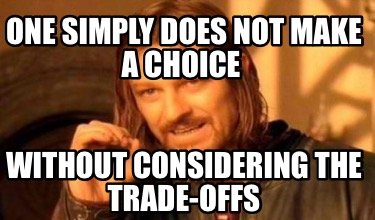A powerful pair of phrases to use when making decisions: Part 1
I recently moved to New York City, which, as my father pointed out immediately, has a much higher cost of living than Chicago, where I had lived for the past 13 years. He wasn’t wrong. During the months-long process where I explored the idea of moving, I thought a lot about so many factors that went into it, and given that I’m a solo parent and the sole breadwinner, finances were a big piece of this.
During this process, I found myself going a lot to a sentence frame that has been really useful to me at various points in my life.
If I do X, it means I might not be able to do Y.
Just like algebra, it requires plugging in a few variables: X and Y. X is what you’re thinking about doing, and Y represents the trade-offs that X might entail.
So for my move, considering finances, it was “If I move to Brooklyn, I might not be able to take as many vacations, or stay at as nice of hotels.”
Sometimes the phrase is more definitive: If I do X, it means I won’t be able to do Y.
“If I move to Brooklyn, I won’t be able to afford a place as nice as our home now.”
Composing the phrase is the first step: then, it’s sitting with it and reacting. What does this feel like? How does my body react to it? What is coming up for me?
As a leader, sometimes finding that time to sit and think is the hardest part—but the phrase is so short and succinct that it means that you can think about it when you are at the grocery store, stuck in traffic or taking a shower. Use those natural moments of contemplation and blank space to just sit with it—what is it like?
I used this in my CEO life too, often when I was weighing a big investment.
“If I hire a coach for myself, it means I might not be able to staff up mid-year flexibly if I need to.”
“If I invest in this training for all my leaders, it means I won’t be able to add to our cash reserve goal.”
This phrasing is particularly helpful with things that have finite limits, like time and money. Isolating the potential impact into a phrase helps distill your concern into a distinct idea and lets you think about what that means.
When I thought about this example (“If I hire a coach for myself, it means I might not be able to staff up mid-year flexibly if I need to”), I realized that part of my fear was thinking about “What if?” A social worker I know taught me a nifty trick—“what if” is a stress question. Spending time mulling over this phrase helped me realize my hesitation about investing in a coach was really about being concerned I would limit my Future Self’s ability to respond to an issue in the future, because I hypothetically would not have as many resources at my disposal to use to combat potential issues.
Sometimes mulling over this phrase helps me to explore the dynamics of how I am feeling about a particular issue. In this example--“If I invest in this training for all my leaders, it means I won’t be able to add to our cash reserve goal.”—it became clear to me that I had a lot of anxiety around not adding to our cash reserve. As I thought about it, I considered why: my school was growing at that time, so our reserve had to grow with “days of cash on hand”—the school cost more to run every day in year 4 than in year 2, so I had to constantly be thinking about how to put money towards that. My Board Treasurer cared a lot about this number, as did our authorizer, and so in our monthly Finance Committee meetings it always came up. This helped me to do some math and think about where our reserve was currently (a respectable level), think about the impact on instruction I thought this training would have for our leadership team (it looked very promising and was definitely needed) and weigh these two considerations against each other. I realized what I wanted was to stop getting questions every month about our reserve, and the solution to that was about aligning with my Treasurer what was a good number to have in reserves, and what level of annual contributions we needed. Once we aligned on that, the questions would slow (he was a really conscientious Treasurer, so they wouldn’t stop, which was fine—but this way I could say, “We talked about between A and B being the right number for this year, and we’re right in between them”).
This phrase always got me off to a great start in really distilling what I was most concerned about, and that information pointed me in a direction to consider those issues and examine what was behind them. That usually led me to the next phrase, which I’ll talk about next week.
Comment below and let me know times you might use this framework in your life!
Be sure to subscribe to my newsletter to be the first to see new content like this…plus exclusive extras just for my list!

